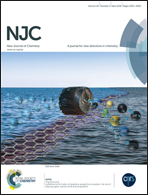Theoretical studies to investigate the effect of different cores and two different topologies on the optical and charge transfer properties of donor materials for organic solar cells†
Abstract
We have designed three dimensional conjugated three- and four-armed molecules for organic solar cells, featuring a bithiophene donor (DF) fragment connected to a pyridine-thiadiazole acceptor fragment (AF) via an ethyne π-spacer (Ps) as the arms, which are linked to different central core atoms (N, B, C and Si atoms) based on two topologies, “core-D–π–A” (molecules are named N3-Mol, B3-Mol, Si4-Mol and C4-Mol) and “core-A–π–D” (molecules are named N3-RMol, B3-RMol, Si4-RMol and C4-RMol). A combination of density functional theory (DFT) and time-dependent-DFT (TD-DFT) approaches is applied to understand the effect of different central cores on the optical, electronic and charge transport properties of the two topologies. The “core-A–π–D” type molecules display smaller Eg values than those of the “core-D–π–A” type molecules. Therefore, the “core-A–π–D” type molecules show a significant red shift in λmax compared to the “core-D–π–A” type molecules. The molecules C4-RMol, Si4-RMol, B3-RMol and N3-RMol show red shifts of 59, 14, 28 and 39 nm in λmax as compared to C4-Mol, Si4-Mol, B3-Mol and N3-Mol, respectively. Three-armed N3-Mol and N3-RMol display the largest λmax of the designed molecules. Interestingly, B3-RMol and C4-RMol show more or less same λmax values. However, B and Si cores also show more intense absorption bands than N and C cores, respectively. Both the reorganization energy and mobility results reveal that the four-armed molecules show higher charge transport rates than the three-armed molecules because of their better dimensionality. N3-RMol exhibits μe and μh mobilities of up to 2.8 × 10−2 cm2 V−1 s−1 and 3.3 × 10−2 cm2 V−1 s−1 respectively while C4-RMol shows higher μe and μh mobilities of up to 0.163 cm2 V−1 s−1 and 4.14 × 10−2 cm2 V−1 s−1 respectively in the crystalline state, which have been predicted using the P21/c space group. Thus, the comparative analysis of the designed molecules reveals that the “core-A–π–D” topology with the substitution of N and C cores results in molecules which exhibit a narrow Eg, broad and intense absorptions and an anisotropic high charge carrier mobility in the crystalline phase, which is associated with low reorganization energies for organic solar cells.


 Please wait while we load your content...
Please wait while we load your content...